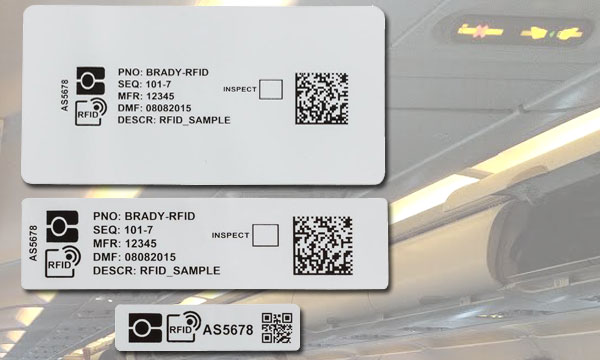MRO Europe: Brady launches RFID Air, a new, ultra-slim RFID label for non-metal surfaces |
| Romain Guillot |
|
|
31 OCT 2018 | 347 words
|
 |
|
|
|
|
Brady Corporation has just launched a new, ultra-slim RFID label for the aviation sector. Named RFID Air, this label is applied to non-metal surfaces, specifically targeting cabin equipment (life vests, oxygen masks, safety equipment, etc.).
RFID Air is available in 3 different sizes, weighs under one gram and is 0.23mm thick. The RFID chip may be scanned up to 8 metres away. Brady is specifying that this label can stand up to extreme environmental conditions without needing a protective film. It is compatible with temperatures between -40°C and 85°C in pressurised or non-pressurised environments. RFID Air is ATA Spec 2000 and AS7578 certified.
The American company was already proposing RFID labels for metal surfaces for the aviation sector, a market which has expanded since Airbus decided to use RFID technology to trace parts on all its family of aircraft.
As David Verloes, Europe, Middle East and Africa Product Manager for Brady Corporation's identification solutions "In 2013, Brady decided to become the RFID market leader for the aerospace sector and developed a durable, ultra-light label that could be printed on site and was able to withstand all conditions, both inside and outside a commercial aircraft's cabin, on the ground or in flight".
He says that RFID chip marking for parts is a response to the growing need to identify components effectively and error-free in supply chains which are increasingly complex and globalised. Identifying each component with an RFID label enables automated data entry, real-time production and stock visibility, complete visibility over the logistics chain and rationalised business processes.
It provides advantages in managing components during their full life cycle and responds to the needs of suppliers, integrators, airlines and MROs, particularly in the context of operational process automation.
Brady proposes a simultaneous on-site RFID chip printing and programming service in under ten seconds. The labels are printed with 600 dpi resolution. In addition, the software provided conforms to the ATA Spec 2000 standard and enables data to be entered manually or automatically with the integration of a validation process. |
|
 |
Romain Guillot
Chief editor
Cofounder of Journal de l'Aviation and Alertavia
|
|
| |
They made this section possible |
|
|
|
|
|
|
|
|
|
|
|
|
|
|
|
|
Top stories |
|
|
|
|
|
Top stories
|